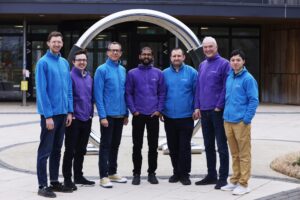Five minutes with Jonathan Musgrove, CEO of Oxford Sigma
November 6, 2023

We are pleased to welcome fusion materials technology start-up Oxford Sigma to our Oxford Centre for Innovation (read the news story here). We sat down with co-founder and CEO Jonathan Musgrove to discover more about their work and vision for the future of the company.
Enabling fusion technology
“Our goal is to enable fusion to be the energy of the future, by playing a significant role in the supply chain,” says Jonathan. Nuclear fusion, the same process that powers the Sun and stars, holds great promise for an abundant and dependable supply of cleaner carbon-free energy without the same risks associated with nuclear fission.
However, producing energy here on Earth by the same process that powers the Sun has some challenges. It requires extreme conditions, safely contained within a reactor, to pack elements densely enough to cause nuclear fusion. It’s an environment of high temperatures, where plasma erodes materials and where the high-energy neutrons produced alter materials and cause structural damage.
For fusion to be the energy of the future, innovative strategies and solutions are needed to tackle challenges of scaling up for commercial energy supply. Importantly, materials that can structurally withstand the environment of a reactor on a large scale and can harness maximum energy from the fusion process need to be developed.
This is where Oxford Sigma aims to play its part. “If there’s a neutron hitting a material, we will be there to mitigate its impact. We aim to make fusion possible,” says Jonathan.
The start
Oxford Sigma was founded in 2019 by Jonathan and Thomas Davis, but its beginnings had been brewing for much longer. The pair met on their first day as undergraduates at the University of Birmingham and became enduring friends. They had always said they wanted to do something together, but at 18 and 19, had no idea what that might be.
While Thomas worked on his PhD in the Department of Materials at the University of Oxford, he saw a gap in the fusion materials market. Combining his expertise in nuclear fusion materials and Jonathan’s expertise in engineering consultancy and regulatory compliance, they saw they could play a niche role in the sector.
So, they formed Oxford Sigma – a name they chose to represent their work in nuclear technology development through the symbol sigma (σ) and their proud origin in Oxford.
The company started offering consultancy services to fusion energy companies. They provide strategic guidance, road-mapping approaches to develop and utilise materials that can withstand fusion environments on a commercial scale, and draw on their expertise in areas of fusion materials engineering, fusion component design and manufacturing, neutronics, magnetohydrodynamics, and regulatory compliance.
Developing technology
Through their consultancy work and close proximity to the industry, they have been able to identify needs in the sector, and over a few years, have started to develop their own portfolio of in-house technologies to enable fusion.
This includes computational modelling in magnetohydrodynamics, to understand how liquid metals and molten salts interact with magnetic fields in a reactor. They aim to license this to industry as well as use internally in their own product development. They are also developing testing rigs to assess how new materials and components withstand the harsh environments of fusion reactors. This will provide valuable data for their own tech development and for the sector and will, furthermore, support the development of regulatory standards and processes (read more about their work in contributing to the development of fusion powerplant construction standards here).
They aim to build on their own technologies and products going forward and shift focus into tech development and manufacturing for fusion reactors, both in-house as well as in partnership with other industry players.
“What we are developing is agnostic to the fusion approach. We don’t have a bias as to whether a customer is developing a Tokamak-based or Stellarator-based reactor. Our technology will, as much as possible, be suited to all types of reactors.”
The time is right
Despite its challenges, technological development in fusion energy is receiving much support worldwide. The UK government is backing fusion with a strategy to lead the global commercialisation of fusion (read here). The UKAEA STEP programme – Spherical Tokamak for Energy Production – aims to build a prototype power plant by 2040.
Outside of the UK, the US are investing in public-private efforts to develop its first prototype power plant. In Europe, last month the German government announced an additional €370m (£320m) in funding for nuclear fusion research and development (read here).
“It’s the right time for developing fusion materials technology,” says Jonathan. Oxford Sigma intends to be a key player in global technological developments in this area through collaborations.
Expect success and failure
At this phase of fusion technology development, Jonathan expects there will be some successes and failures along the way. “The industry can expect some fast failure in this new tech space. It’s what the industry needs to get to the next level,” he says. Some fusion companies will fail. Some technology won’t achieve what is hoped. Some companies will be successful. Some companies will shift in a different direction. He also expects, as Oxford Sigma grows, that some of their technologies will be successful, while others might not work as expected.
Oxfordshire is the place to be for fusion energy
The UK’s fusion energy efforts are richly concentrated in Oxfordshire. With the UK Atomic Energy Authority (UKAEA) at Culham Science Centre, commercial fusion energy company Tokamak Energy Ltd at Milton Park, First Light Fusion in Yarnton, and the research excellence in nuclear fusion at the University of Oxford, Oxford Sigma are well placed among other industry and academic stakeholders to become a key player in the sector.
With their headquarters at the Oxford Centre for Innovation, they have access to the talent coming out of the University, and are also in a great location for easy travel into and out of the city. They maintain a satellite office at Harwell Innovation Centre, where they started in 2019, and where they are in close proximity to UKAEA.
In a short time, they have grown their team from the founding two to 10 and have built a presence in the global market. Growth has been organic, supported by income from their consultancy services and by recent grants through OxLEP Business Investment Fund and UKAEA Small Business Research initiative.
With their tech developments in the pipeline, they aim to grow their team threefold over the next few years, and will soon be opening up for their first round of seed funding.
We wish Oxford Sigma every success!
For more information on Oxford Sigma, visit their website.
Feature image: Oxford Sigma co-founders Thomas Davis (left) and Jonathan Musgrove (right) outside the Oxford Centre for Innovation.




